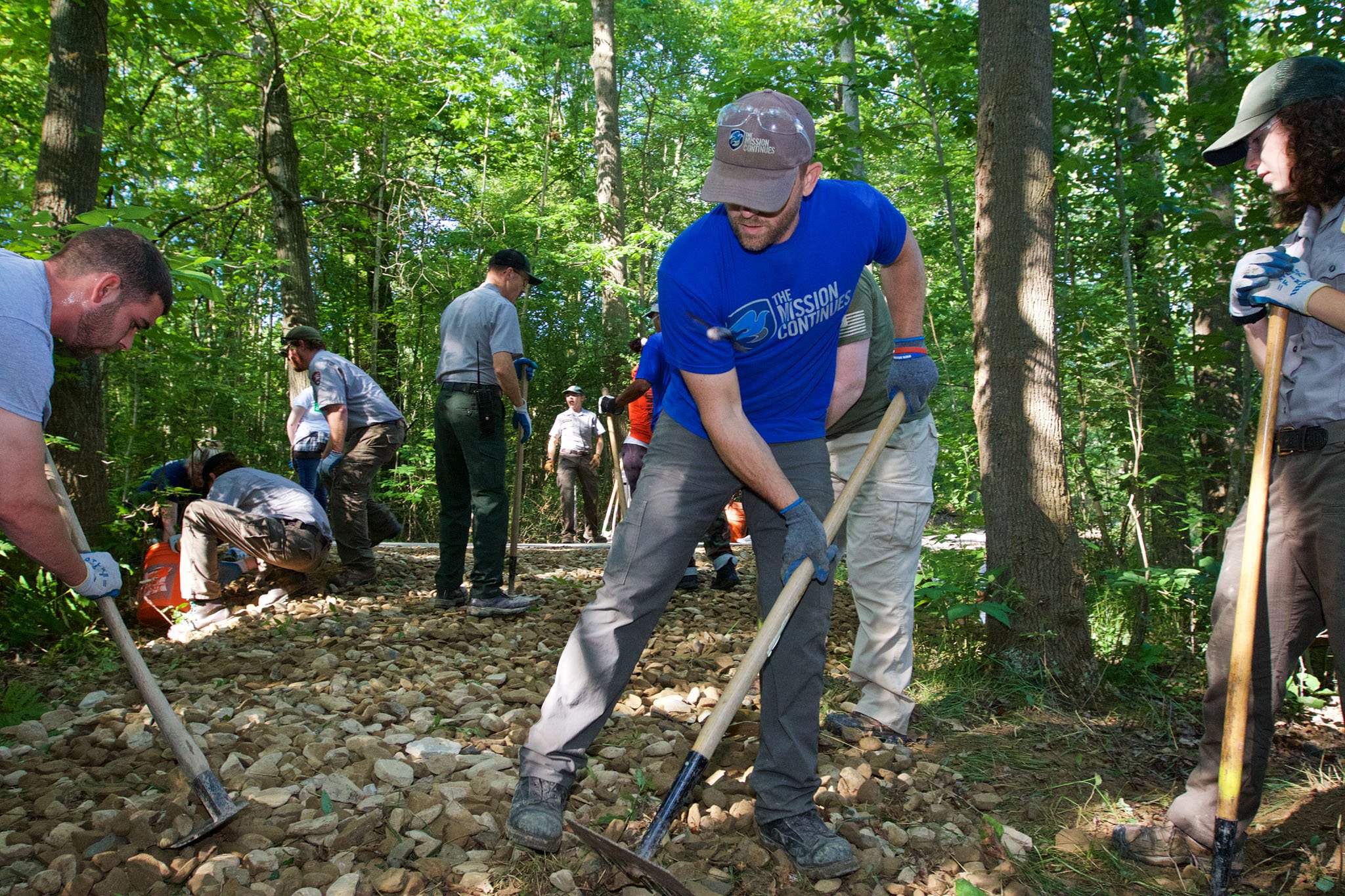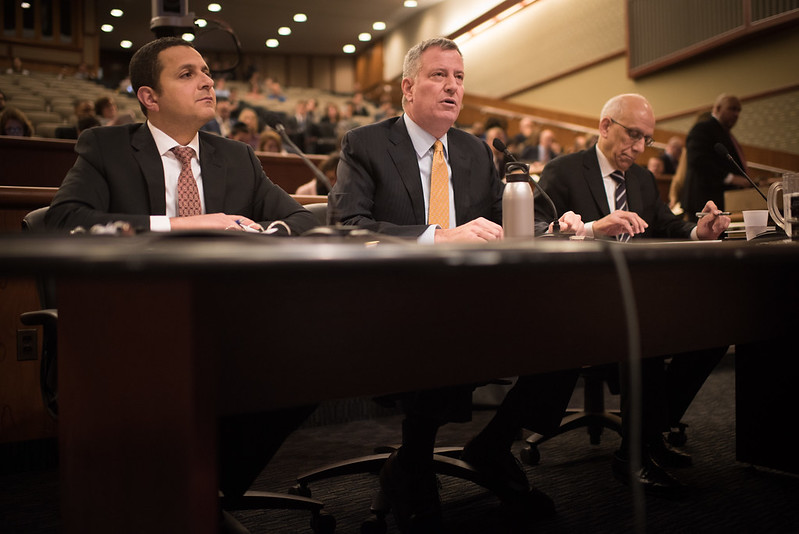Veterans Stand Up for Our National Parks, Time for the Federal Government To Do So Too

(photo: @missioncontinue)
The Statue of Liberty has stood as a symbol of American values for more than a century. Throughout its life in New York Harbor, the landmark has welcomed immigrants to the United States and served as a historical resource for millions.
It embodies the values that have driven our nation from its founding and that our military veterans have dedicated their lives to protect — that of freedom, acceptance, and hard work, all in search of the American Dream.
Since the National Parks’ founding, United States veterans have served as their stewards – protecting and caring for public lands since before the National Parks Service was established in 1916. These veterans created many of the roads, trails, and other infrastructure that visitors to the parks still enjoy today.
Yet, like many National Parks, the Statue of Liberty, the embodiment of those ideals, is currently lagging under $90.2 million of deferred maintenance needs — or maintenance requests that have been put off for a year or more. Nationwide, the National Park Service reported a total of nearly $12 billion of deferred maintenance last year. If we fail to address these needs, they will only get worse and costlier.
The Mission Continues empowers veterans to become advocates for positive impact in communities and has partnered with the National Parks Service and National Parks Conservation Association since 2015 to tackle deferred maintenance projects at parks across the country. Through countless service projects, they’ve restored trails at Sequoia National Park, revitalized campgrounds at Dry Tortuga National Park, constructed new benches for the Statue of Liberty’s Liberty Island, and removed blighted structures while beautifying the grounds at Ellis Island through landscaping and fresh coats of paint.
According to the Ellis Island Park Service, just one day of volunteer service by The Mission Continues can help clear over two months’ worth of the deferred maintenance backlog. These veteran-led volunteers are on the ground, continuing the work of stewarding and improving public lands for future generations, just as the generations of veterans before them did.
However, veterans and volunteer groups alone cannot address the staggering $12 billion in deferred maintenance needs of our National Parks. Luckily, there is bipartisan support in Congress to fix our parks with the Restore Our Parks and Public Lands Act (H.R. 1225), which would address $6.5 billion in deferred maintenance needs in a limited five-year span.
This sound legislation boasts 329 House Representatives as co-sponsors—and it is not just Congress that has demonstrated strong support. A recent survey found that more than 82 percent of Americans back this legislation. It is rare to find such broad support for anything in Congress, so House leadership should move forward on issues where there is common ground and broad public support.
If Congress is truly committed to America’s veterans and the values they fight for, it will do all it can to protect and preserve those values at home. By addressing deferred maintenance at our National Parks through the Restore Our Parks and Public Lands Act, Congress will ensure the safety of visitors, honor veterans’ rich history of serving public lands, protect our values, and ensure that parks and their programs thrive at the Statue of Liberty and across the country.
***
Mary Beth Bruggeman is a U.S. Marine Corps veteran and President of The Mission Continues. On Twitter @mb_bruggeman & @missioncontinue.
***
Have an op-ed idea or submission for Gotham Gazette? Email This email address is being protected from spambots. You need JavaScript enabled to view it.
Taxpayers Fleeced for Nearly $47 Million in Tech Boondoggle But Few City Leaders Notice

(photo: Michael Appleton/Mayoral Photography Office)
What if I told you that in an effort to enable 40 New York City government agencies to buy goods and services more cost-effectively, some city officials have put on a tutorial on how not to buy goods and services – and stuck taxpayers with a bill heading toward $47 million?
As a New Yorker, you’d probably tell me to “Get the hell outta here!” -- then I’d have to give you details.
So here’s how the flimflam went down. Three years ago, city government hired an inexperienced French technology company, Ivalua, to custom-build procurement software for tens of millions of dollars ($30.5 million, to be more precise) to help the city agencies buy goods and services less expensively.
The company’s partner in landing the contract was KPMG, a global professional services firm with deep ties to the mayor’s office and city agencies through well-connected lobbyists.
Two years after the contract was signed, the design hadn’t been completed. Fast forward to today, and few if any of the 40 agencies benefit from the promised customizable, end-to-end e-procurement system. And while officials had the legal ability to cancel the contract and claw back $25 million of the $30 million they’d spent, they chose instead to give the vendor another $15 million to get the software working.
Another increase will bring the expected cost to almost $47 million.
There is procurement software from Bonfire Interactive, Ltd., a Canadian e-procurement firm, that’s readily available for $50,000 and used by Dallas, Texas. But New York City officials dismissively declare the Big Apple is vastly different from other major cities, but don’t address why proven, far-cheaper options were ruled out.
Forty city agencies continue to rely on old-fashioned methods for finding and paying vendors. Yet officials at two agencies, the Department of Information Technology and Telecommunications (DoITT) and the Mayor’s Office of Contract Services, that were directly involved in the contract decision-making process, duck basic, reasonable questions about who enabled this boondoggle in the first place.
Why was a French company that had never worked with any government in the U.S. given a $30.5 million contract by the largest municipality in the nation?
Why are the agencies involved hiding emails and other lawful public records that could shed light on the origins of this scandal?
This is happening now. And few who can do something about it -- like City Council Speaker Corey Johnson -- have taken any action to address it.
Then-DoITT Commissioner Anne Roest, who signed the contract; Chief Procurement Officer Michael Owh, who ran point; and KPMG official Samir Khushalani, who was the “executive sponsor,” have all left town.
Other officials at DoITT and the mayor’s office who were involved have avoided owning the problem. Instead, they have delayed and denied reasonable Freedom of Information Law (FOIL) requests for documents and emails regarding this troublesome contract.
Based on limited records we at Checks and Balances Project uncovered, we discovered that Ivalua’s design had not been completed and requirements were not validated two years after the contract was signed. These public records show that nearly every milestone had been missed.
DoITT, in charge of the project until the mayor’s office took over in January, replaced KPMG with Accenture. And in June 2018, former Commissioner Samir Saini signed paperwork giving Ivalua another $15 million. Since then, according to Checkbook NYC, the city comptroller’s digital database, an additional increase brings the expected price for the software system to $46.89 million.
In a city with an annual budget of more than $92 billion, nearly $47 million might not seem like that much. But it’s real money, the equivalent of:
-188,000 new textbooks for public school students
-1,106 police officers, starting annual salary
-1,040 firefighters, starting annual salary
-23,992 Section 8 two-bedroom housing monthly rental vouchers
-740,157 discounted monthly MetroCards to low-income New Yorkers.
Considering Mayor de Blasio’s oft-stated focus on creating more middle class jobs, throwing more wasted money at an expensive, custom e-procurement system that doesn’t work as promised is especially disappointing.
There are several officials and institutions that have the ability to do something about this growing contract scandal: Comptroller Stringer; Public Advocate Jumaane Williams; Speaker Johnson; the City Department of Investigation; City Council Member Ben Kallos, who chairs the Contracts Committee and sits on the Oversight and Investigations Committee, and other Council members; and city media. Only Stringer and Kallos have taken any interest in the wake of a Daily News story on the boondoggle.
Playing fast and loose with public funds isn’t a new thing in New York City. But that doesn’t mean it’s OK. The question is, who will do something about it?
***
Scott Peterson is executive director of Checks and Balances Project, an investigative watchdog that seeks to hold government officials, lobbyists, and corporate management accountable to the public. On Twitter @CandBP.
***
Have an op-ed idea or submission for Gotham Gazette? Email This email address is being protected from spambots. You need JavaScript enabled to view it.
A Better Trail to New Rail and Parkland in Queens

QueensLink rendering
The Rockaway Beach Branch right-of-way is a 3.5-mile, skinny strip of land that holds the key to transforming our borough in two fundamental ways. First, it will connect north and south Queens with the rest of the city in an environmentally sustainable way. Second, it will create up to 33 new acres of park space adding value to local neighborhoods and the entire city.
This dual-purpose project is called QueensLink.
It was disappointing to read “A Greenway for Queens” (December 5), where the authors continue to deny the need for better transportation. While the Manhattan-based Trust for Public Land apparently believes Queens doesn’t need more transit, riders and residents, who face some of the longest commutes in the nation, would disagree.
The QueensLink would bring travel time from Howard Beach to Midtown Manhattan down from over an hour to 45 minutes as well as create faster trips throughout the borough and to Brooklyn.
The authors repeat the myth that new transit and new parks can’t be built along this corridor, but this belies the simple fact that in most other places using land for both uses is common. In Oakland, CA, the BART system was built along an old freight rail line that was converted to rapid transit with land at ground level used for a parkway. Miami, Vancouver, Boston, and Atlanta have all incorporated parks along their transit lines. QueensLink would create up to 33 acres of new park space connecting north and south Queens.
Queens has 2.3 million inhabitants but the fewest subway miles per resident of the four boroughs with subway access. Roads like Woodhaven Boulevard. and Van Wyck Expressway are constantly congested while buses are overcrowded and average just 8–10 mph. Subways are the fastest, cleanest, and most efficient way to move many people great distances.
While adding a modest 3.5 miles to the system, the value is most apparent in the connections the QueensLink offers. Finally, riders could get from north to south Queens on one train without having to ride through Manhattan and Brooklyn. Brooklyn riders could access jobs in Queens more easily. The QueensLink would connect to every east-west transit line in Queens to offer the most options for commuters.
The status quo of pitting two sides against one another so nothing is ever done has to end. At this critical juncture in our borough’s history we need individuals and organizations that will rise above the NIMBYism of the last generation. We need thought leaders and elected officials with vision and the courage to advocate for projects that achieve the greater good rather than continue to protect the narrow interests of the well-heeled and well-connected few.
When you have a valuable public asset like the Rockaway Beach Branch right-of-way it is crucially important to analyze what use or uses represent the greatest public good. We have one shot at getting this right, so let’s take an objective look at that question and see where the facts lead us.
The MTA released its long-delayed Rockaway Beach Branch reactivation study last month and the conclusions were gratifying. The MTA determined that reactivating the line as a subway from Queens Blvd., Rego Park to Howard Beach, JFK Airport was feasible. The study also determined that 47,000 riders a day would use the line, a conservative figure since it does not include connecting passengers.
Much of the extra costs included by the MTA were due to their extended projected construction schedule of ten years that should take no more than two to three. While the total MTA number associated with the project was $8 billion, the hard construction costs are about $1.6 billion. Experts have estimated that a design-build approach should result in a total cost of about $2 billion. Still a formidable number but a more realistic one.
Even with lower costs, building the rail and park will require thinking outside the box. QueensLink is developing a new funding strategy that incorporates transit-oriented development and value capture through a public-private partnership.
QueensLink takes inspiration from the LIRR Third Track, a large rail infrastructure project that, like the Rockaway Beach Branch, was bogged down by small thinking for decades. Now this $2.6 billion, 9.5-mile project is underway and on-time and on-budget. Local communities along the rail played a big part in the planning and design, which ultimately led to its success.
QueensLink represents an investment in transit equity that will help people reach education, employment, and recreational opportunities that were out-of-reach before. It is also fully aligned with city and state environmental initiatives to reduce congestion on our roads and the carbon emissions that come with it.
Queens is now at the crossroads. The borough’s residents and elected officials will soon have to decide if we will rise to the challenge of working together for our common good or against each other to our common detriment. The good news is that we don’t have to decide between a rail and more green space, a well-designed QueensLink can and should provide both.
***
Rick Horan is the Executive Director of QueensLink and Andrew Lynch is the Chief Design Officer. On Twitter @thequeenslink.
***
Have an op-ed idea or submission for Gotham Gazette? Email This email address is being protected from spambots. You need JavaScript enabled to view it.




